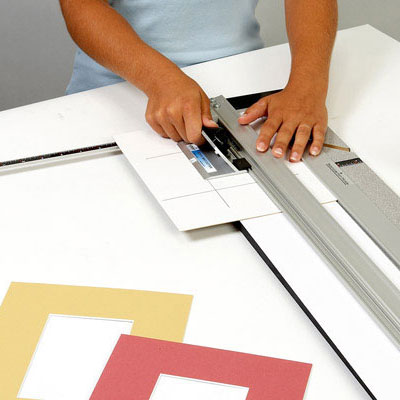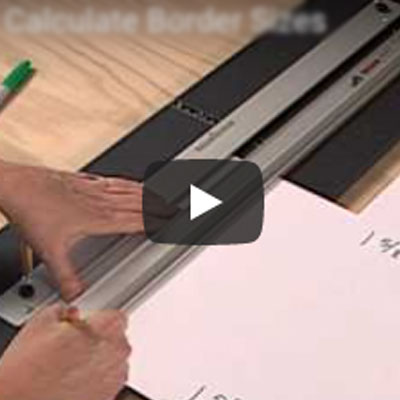The first step in good mat cutting is to understand common problems and how to deal with them and among the most common problems in mat cutting are overcuts and undercuts.
An overcut is an incision that passes beyond the corner of the mat's window into the face of the mat. You would think that the manufacturers of mat cutters could design their equipment so the blade would stop precisely on the corner. Yet this is easier said than done. Where the blade starts and stops is due in part to the thickness of the matboard—and matboard varies a great deal in thickness.
Matboard is available in a variety of different cores. The core is the inside part you see when you bevel cut the mat—bevel cutting refers to cutting the mat at a 45-degree angle. The bevel is the sloped edge that results. Most mats are cut with a beveled edge on the window so the core is quite evident. There is regular cream core matboard, white core rag matboard, regular bleached core matboard, black core matboard, etc. These cores vary in thickness; consequently, there can be a variation in thickness from one type of matboard to another.
In addition, the paper that's laminated onto the core can vary in thickness. These face papers give each mat its distinctive color and texture. Consequently, when you change from one color of mat to another, you may encounter a difference in thickness. Bottom line, when you change from one mat to another, it is not unusual to encounter a difference in thickness.
The thickness of the mat affects where the blade starts and stops because as the blade penetrates the mat it moves downward at an angle. Since the mat is typically cut face down, this means the blade enters the back of the mat at a point farther back than it emerges from the face.
After cutting your first mat, you may discover that your corner is not perfect, that you have an "overcut". Because the blade moves downward at an angle, it may occur to you to address the problem by adjusting the depth of the cut. This is quite logical.
Since the blade is housed in the mat cutter at an angle, if it is cutting too deeply, it's also extended out too far, meaning that when you get to the end of the cut the blade passes beyond the intersecting cut and gives you an overcut. By adjusting the depth of the cut, it is possible to adjust out the overcut. Fair enough. But eventually you will change to another thickness of mat and the problem will occur again.
Let's say the next mat is marginally thinner than the mat you cut before. As you cut, the blade penetrates the back of the mat at the same point it did previously, passes through the core at an angle, yet emerges from the face sooner than it did previously—because this mat is thinner. Now you again have an overcut!
If you start with no overcuts and change to a thinner mat, you will get an overcut. If you start with no overcuts and move to a thicker mat, you will get an undercut. Overcuts and undercuts are directly related to the thickness of the matboard and, unfortunately, you're changing thickness of matboard more often than you think. So what are you supposed to do? How do you get a perfect corner?
Start by changing the way you think about mat cutting. The start and stop indicator line that's supposed to tell you where to begin and end each cut cannot be exact because it does not move around on the cutting head to accommodate the different thicknesses of matboard you encounter. Instead, think of the indicator line as a reference, a gauge that can be moved in relation to the pencil lines in order to achieve the results you want. To eliminate overcuts and undercuts, first diagnose the overcut situation as it exists and then use that information to move the start/stop indicator line in proper relation to the pencil lines.
The easiest way to form a diagnosis is to make some test cuts in the area of your mat that will become the drop-out piece. Mark some lines and cut a test corner there. See what your overcut/undercut situation looks like. Using that information, prepare to cut the actual window but move the start/stop indicator above or below the pencil line by the degree necessary to eliminate the over- or undercut. If you are using a cutting system with production stops instead of a start/stop indicator line, the same problem exists and the same solution is called for, except that with production stops it's a matter of moving the stops on the scales by the degree of the over- or undercut.
Conquering overcuts and undercuts is a matter of understanding why they are occurring and taking proper steps to deal with them before they occur. The mat cutter cannot do this for you. It requires your knowledge and input in the form of delicate adjustments to achieve perfect corners. Do this and your mat cutting will improve dramatically.












